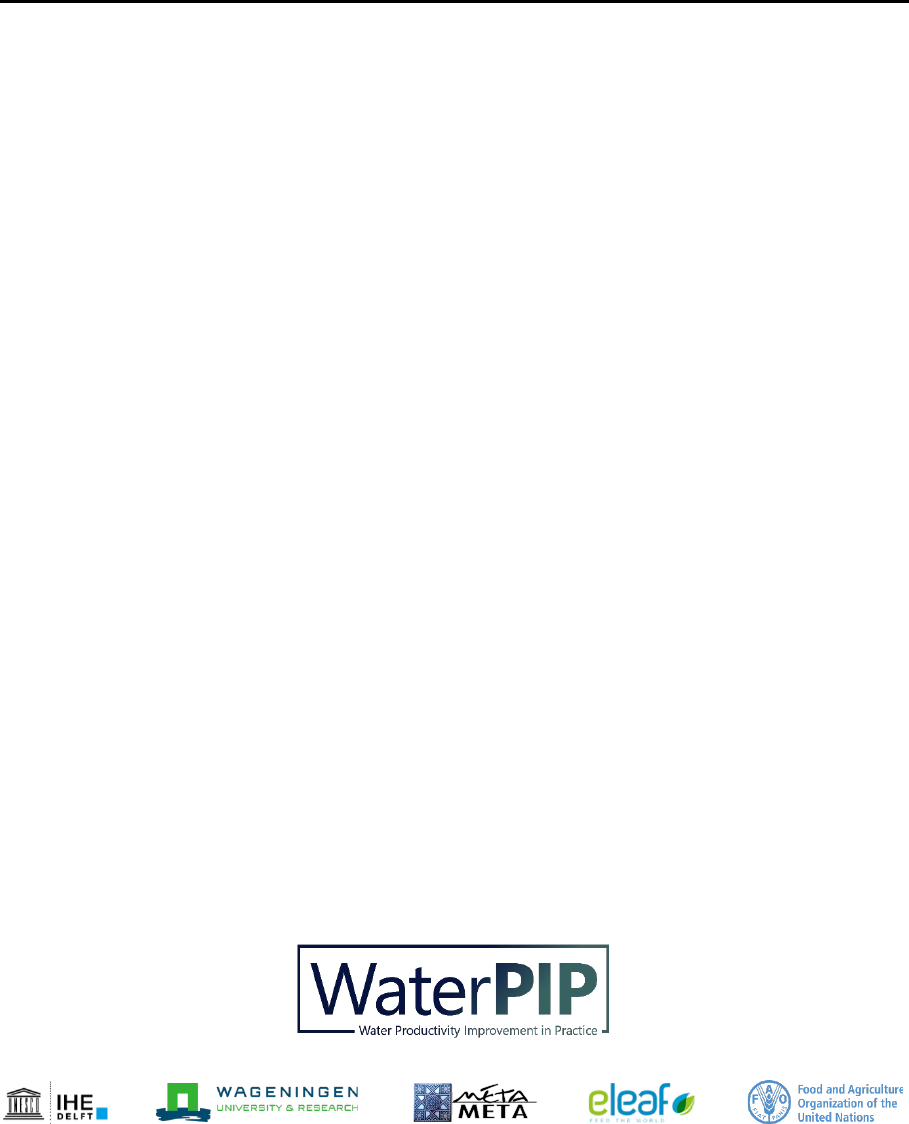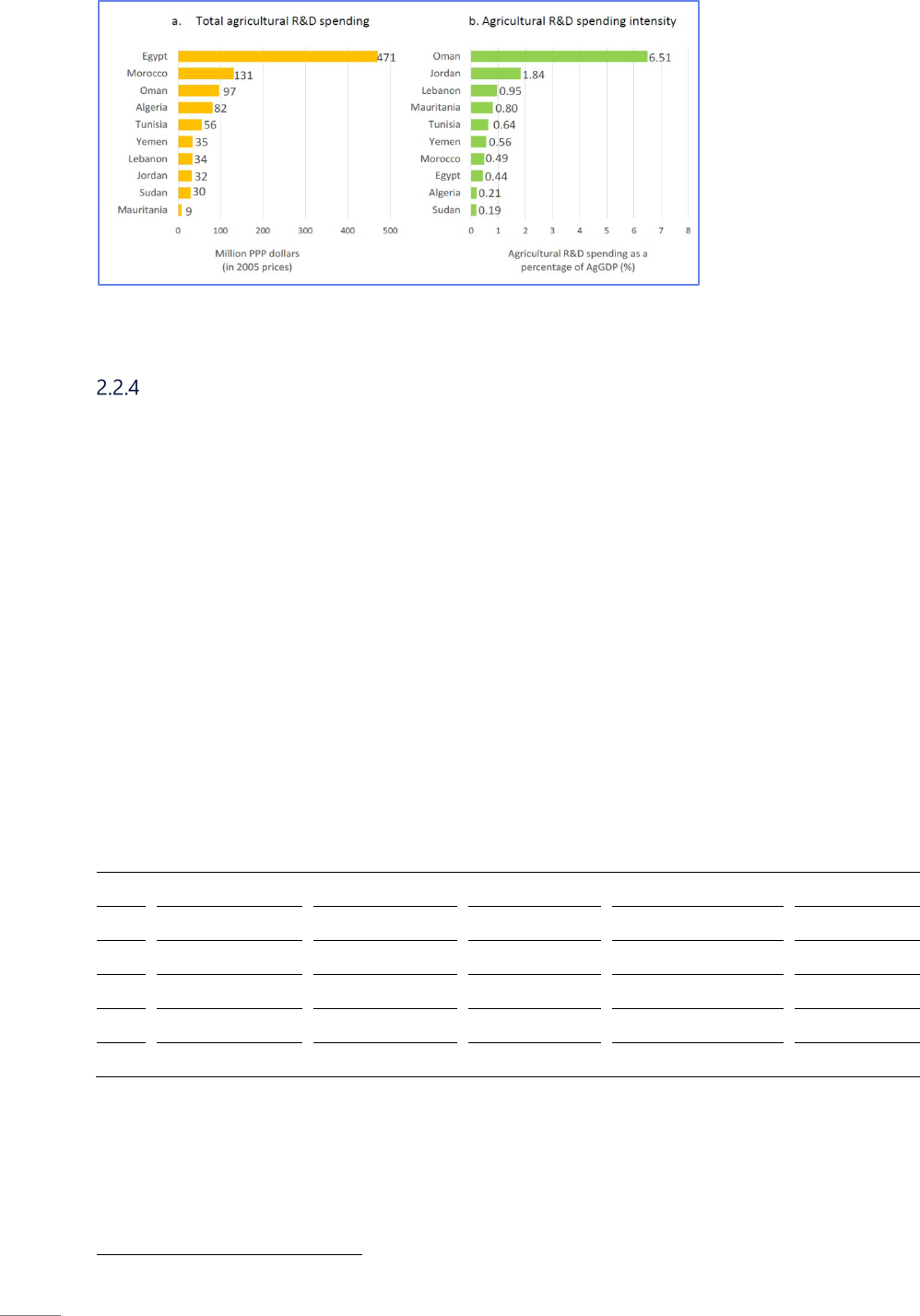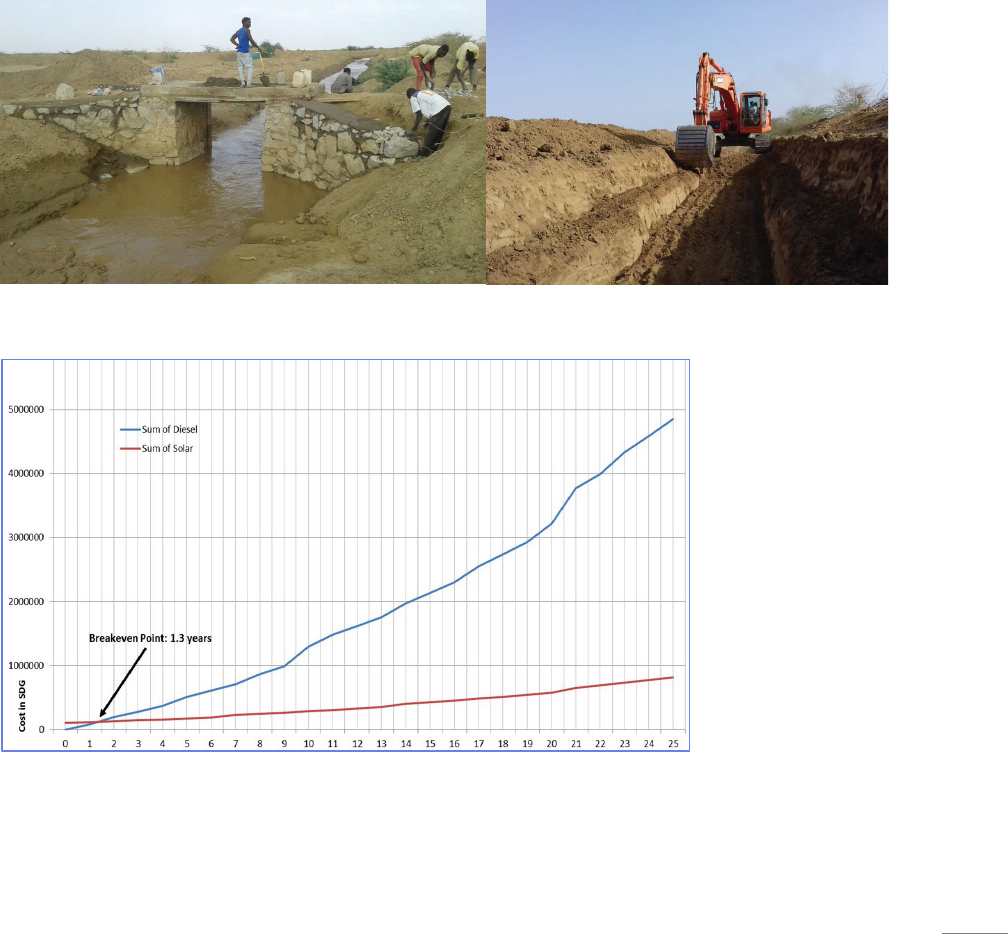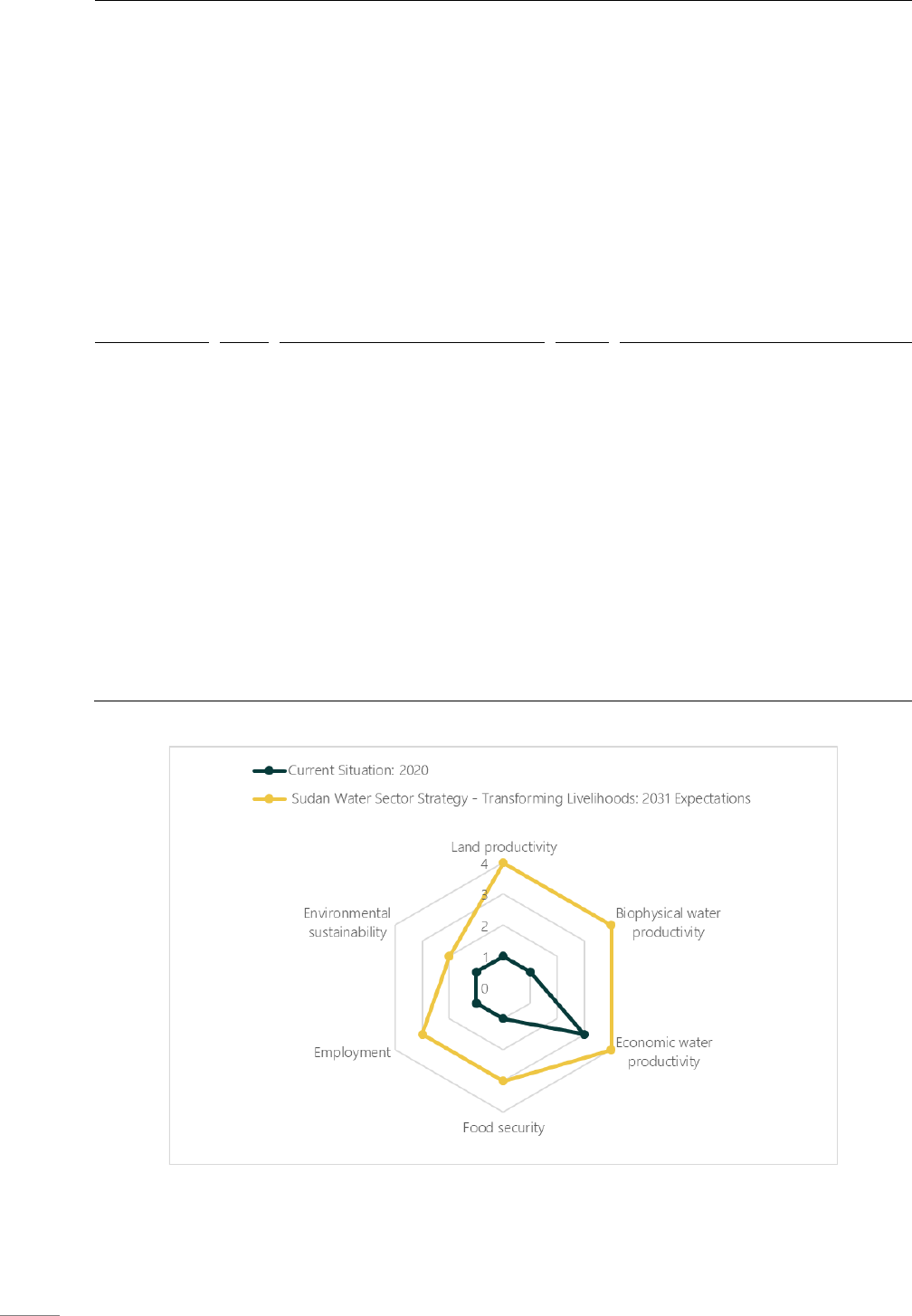
Sudan Water Policy Review and
Analysis
November 2021

Sudan Water Policy Review and Analysis
Water Productivity Improvement in Practice
November 2021
Prepared by MetaMeta

Prepared by Esmee Mulder and Frank van Steenbergen (MetaMeta), duly acknowledging the review by
Wageningen University and Research and IHE Delft Institute for Water Education
Citation: Mulder, E., van Steenbergen, F., 2021. Sudan Water Policy Review and Analysis. Water-PIP technical
report series. IHE Delft Institute for Water Education, Delft, the Netherlands.
This work is licensed under a Creative Commons Attribution-NonCommercial 4.0 International License
.
@2021 IHE Delft Institute for Water Education
This report was developed by the Water Productivity Improvement in Practice (Water-PIP) project, which
is funded by the IHE Delft Partnership Programme for Water and Development (DUPC2) under the
programmatic cooperation between the Directorate-General for International Cooperation (DGIS) of the
Ministry of Foreign Affairs of the Netherlands and IHE Delft (DGIS Activity DME0121369)
The views expressed in this publication are those of the author(s) and do not necessarily reflect the views
of DGIS, DUPC2, or its partners.

Table of Contents
i
Table of Contents
1 Water resources and agricultural productivity ............................................................................................................ 1
2 Policy review: objectives, process and results ............................................................................................................ 3
2.1 Objectives and process ............................................................................................................................................. 3
2.2 Existing Acts and Policies – Gap Analyses .......................................................................................................... 3
The Irrigation and Drainage Act ........................................................................................................................ 3
The 2005 Gezira Scheme Act ...................................................................................................................... 3
The 1995 Water Law ....................................................................................................................................... 5
2007 Water Policy ........................................................................................................................................... 6
2.3 Water for the New Sudan – Transforming Livelihoods Strategy ................................................................ 8
2.4 Comparative Assessment: Current Status and Future Outlook ............................................................... 10
3 Positioning the new national water policy for improved water productivity ................................................ 15
Policy support for water productivity ............................................................................................................ 16
Policy Relevant Water Productivity Analyses .............................................................................................. 18
4 References ............................................................................................................................................................................ 19
Annex 1: Sudan water acts and regulations drafted in the past decades, but were inadequately enforced.
........................................................................................................................................................................................................... 20
Annex 2: Anchoring pillars of the proposed new national water policy .................................................................. 21

List of Figures
ii
List of Figures
Figure 2-1: Small (1.8 m wide), heavy and ineffective buckets in use by the local private sector in Gezira
Scheme (Credit: MetaMeta, 2019) ............................................................................................................................................ 4
Figure 2-2: New generation, wide (5.5 m) effective buckets currently being produced by the Netherlands
private company Herder that was active in the Gezira Scheme back in the 1990s. The MoIWR has re-engage
with Herder to explore collaboration opportunities (Credit: MetaMeta, 2019) ....................................................... 4
Figure 2-3: Absolute and relative agricultural Research and Development (R&D) spending levels ................ 6
Figure 2-4: Low-cost intake and field canals that contributed to improved field water management and
productivity in Gash seasonal river based agricultural scheme in Sudan (Credit: Amira Mekawi, HRC) ........ 7
Figure 2-5: Cumulative groundwater pumping cost over the 25-year life of solarized systems versus the
existing diesel generator systems (EC-HACP and GSWI, 2017). .................................................................................... 7
Figure 2-6: Spider diagram comparing the current situation and priorities in the Water for the New Sudan
– Transforming Livelihoods Strategy .................................................................................................................................... 14
List of Tables
Table 2-1: Location and scope of the Medium Size Pump Irrigation Schemes (MoIWR, 2018) ......................... 6
Table 2-2: Overview of indicators used in the assessment ........................................................................................... 10
Table 2-3: Assessment of the current situation and the priorities in the new water sector Strategy ............. 11

Acronyms
iii
Acronyms
ARC Agricultural Research Corporation
EMC Earth Moving Cooperation
HRC Hydraulic Research Centre
FAO Food and Agricultural Organisation of the UN
FOP Field Outlet Pipes
GDP Gross Domestic Product
GSA Gezira Scheme Act
GSWI Global Solar-and-Water Initiative
IARP Irrigated Agriculture Rehabilitation Programme
IOD Irrigation Operations Directorate
IRWR Internal Renewable Water Resources
MoIWR Ministry of Irrigation and Water Resources
NCWR National Council for Water Resources
NGO Non-Governmental Organizations
NWAP National Water Resources Allocation Plan
O&M Operation and Maintenance
R&D Research and Development
SIWI Stockholm International Water Institute
WAP Water Allocation Plan
WaPOR FAO portal to monitor Water Productivity through Open
access of remotely sensed derived data
WP Water Productivity
WUA Water User Association

Water resources and agricultural productivity
1
1 Water resources and agricultural productivity
Sudan is a water scarce country with the Internal Renewable Water Resources (IRWR) estimated at 32 billion
m
3
/year bringing the per capita water availability below the water stress threshold of 1,000 m
3
/year
(MoIWR, 2021). The Nile river contributes the largest share – 20.5 billion m
3
/year measured at the Sennar
Dam on the Blue Nile (Elamin, 2013). This amount is in line with the 1959 agreement that governs the Sudan
water share of the estimated 84 billion m
3
annual average Nile river flow recorded at the Egyptian Aswan
Dam at the border between the two countries (FAO, 2015). The seasonal streams and groundwater
resources provide about 6.7 billion m
3
/year and 4.8 billion m
3
/year respectively (MoIWR, 2021). Rainfall is
marked by erratic intensity, large seasonal variability, uneven distribution and concentration in a short-wet
season. Average annual rainfall is 200 mm/year, but ranges from 25 mm/year in the dry north up to 700
mm/year in the south (FAO, 2015).
The agriculture sector is the biggest consumer of water resources at more than 90% (FAO, 2015). It is also
the largest potential contributor to the Sudanese economy. It provides livelihoods and job opportunities
for nearly 70% of the country’s estimated 44 million population. Before the oil exports came on line in
1999, agricultural products accounted for upwards of 95 percent of exports and the sector contributed to
nearly 60% of the GDP (Berry, 2015). In the past three decades, however, the agriculture sector has been
on a declining trend due to a combination of factors: neglect by the then government as more attention
went to the oil and services sectors; lack of up-to-date coherent policies and strategies resulting in
inadequate investment, research and capacity building programme (MoIWR, 2019); internal conflicts and
instabilities, particularly in the Western and Eastern agricultural hubs (Mahgoub, 2014).
The agricultural production and productivity is currently low compared to global averages or potential
local targets from the Sudanese Agricultural Research Corporation (ARC). For instance, the 2.4 tons/ha
yield of wheat (FAO, 2019) is 50% of the local target and far below the attainable 6 to 9 tons/ha reported
in the FAO AQUASTAT Database
1
. Wheat is the most important staple and commercial commodity in
Sudan at the moment. In the 2019/2020 cropping season, the 730,000 tons local wheat production covered
just a third of the 2.6 million tons actual consumption. The country is currently filling the gap through
import, which amounted to $500 million draining the meagre national hard currency reserve and triggering
a cascading negative impact on the economy (Ahmed and Mehari, 2020). Importing wheat is also reliant
on international market dynamics, which the country cannot fully control and this has often resulted in
short supply of bread, a very essential staple food for millions of Sudanese. The yield of sorghum (< 1
ton/ha), another major food crop is also low as compared to the achievable 3.5 to 5 tons/ha. Sugar cane,
a highly commercial crop fares far worse at 10 tons/ha – the optimum yield ranges from 50 to 150 tons/ha.
The Water Productivity (WP) of the major crops is also very low. For instance, as documented by the on-
going FAO funded water productivity improvement project in Gezira irrigation scheme, the majority of the
farmers apply nearly twice the wheat irrigation requirement or about 8,000 m
3
/ha (HRC, 2019). At 2.4
tons/ha, this results in 0.3 kg/m
3
, which is significantly below the optimum range of 0.8 to 1.6 kg/m
3
.
Likewise, the WP of sorghum (0.15 kg/m
3
) is just 15 to 25% of the achievable 0.6 to 1 kg/m
3
. This sorghum
WP analyses is based on the 2017 to 2019 flow measurements conducted in the Gash agricultural scheme,
the major source of food and fodder in Eastern Sudan (HRC and MetaMeta, 2020). The Gash farmers supply
6,200 to 7,140 m
3
/ha while the yield rarely exceeds 1 ton/ha.
The February 2019 Water Sector Conference that brought together more than 150 international and local
professionals (the WaterPIP consortium was represented) highlighted lack of coherent policy roadmap as
one of the major factors for the low agricultural production and water productivity. The frequently cited
1
http://www.fao.org/land-water/databases-and-software/crop-information/en/

Water resources and agricultural productivity
2
draft 1995 Water Law and the draft 2007 Water Policy were never officially endorsed due to mainly neglect
by the then Ministry of Water Resources, Irrigation and Electricity. The Conference participants agreed that
the policies are out-dated and do not adequately respond to the Sudan water sector needs of the present
and the future. They accordingly suggested the development a new water strategy and policy (MoIWR,
2019).
The decline in the performance of the agriculture sector has negatively impacted the livelihoods of millions
of Sudanese people, particularly the rural poor farming and herding communities. Sudan currently sits at
the bottom-end of the global food security index, 112
th
out of the 113 countries evaluated
2
. Nearly half of
the total population and three quarters of the vast agrarian communities live in poverty (IMF, 2013).
Since the Peaceful Great Revolution of December 2018, the Ministry of Irrigation and Water Resources
(MoIWR), the custodian of water resources in Sudan, is working to deliver an inclusive economic growth
that improves the lives and livelihoods of the Sudanese people. The Ministry prepared in the fall of 2020,
a 10-year Water for the New Sudan – Transforming Livelihoods Strategy. This became operational in March
2021. The Strategy is to be followed by the drafting of a National Water Policy in 2021 as well.
These policy efforts by the MoIWR are also in anticipation of the fact that the desire to achieve rapid
economic growth will increase competition for the limited water resources. This is already seen in places
like Kassala, Nyala and El Fasher between agricultural and urban water demands. As competition increases
between various demands on water, strategic plans and policies are needed to inform decisions on water
use, control, protection and development so as to be able to ensure sustainable growth and avoid ad-hoc
planning and implementation.
2
https://foodsecurityindex.eiu.com/

Policy review: objectives, process and results
3
2 Policy review: objectives, process and results
2.1 Objectives and process
The purpose of this review is two-fold. The first part discusses the aspects of the Acts and Policies that
contributed to the current poor status of the agricultural production, water use efficiency and productivity
as well as food security, job creation and other related socio-economic development issues. This second
part presents the future outlook as defined by the ambitions and targets of the National Sudan Water
Sector Strategy: Transforming Livelihoods 2021-2031.
2.2 Existing Acts and Policies – Gap Analyses
Sudan has drafted many water acts and regulations over the past decades (Annex 1). Among these, the
1990 Irrigation and Drainage Act and 2005 Gezira Scheme Act have had the most direct impact on the
current poor performance of the agricultural sector. As indicated earlier, the country does not yet have an
endorsed up-to-date water policy. The most widely cited 1995 Water Law and the draft 2007 Water Policy
are analysed here as several of their gaps could be traced to the decline of the agriculture sector in the
past three decades.
The Irrigation and Drainage Act
The 1990 Irrigation Drainage Act is very much regulatory in nature. Its most prominent provisions stipulate
that any work related to irrigation or drainage needs a permit from the MoIWR and that licensee shall
notify the Ministry to draw water for irrigation, whether from the Nile River or any of its tributaries or any
other rivers or public canals (UNEP, 2012). The Act is relatively silent on the facilitative and enabling aspects
of water management: improved living conditions, providing career paths and capacity development
opportunities for irrigation and water professionals and practitioners and mechanisms to improve irrigation
and related farming services to farmers and other beneficiary groups. This has contributed to poor
operation and maintenance and low crop and water productivity of the four national large-scale irrigation
schemes (Gezira, Rahad, New Halfa and Suki) that cover nearly 2 million ha.
The need to strengthen the facilitative roles of Acts and Policies was recognized in the 2016 international
conference on revitalization of the Gezira irrigation scheme (MoIWR, 2016). Human Resources and Services
(training, improved housing, office and communication facilities) was identified among the top five priority
improvement intervention packages.
The 2005 Gezira Scheme Act
The overarching goal of the 2005 Gezira Scheme Act (GSA) was to transfer significant irrigation water
management and related farming responsibilities from engineers and agricultural officers to farmers. The
specific objectives included ensuring farmers’ right to: (i) effectively participate, at all administrative levels,
in planning and implementation of projects and programs that affect their production and livelihoods, (ii)
manage irrigation operations at field canal level through water users’ associations, and (iii) freely manage
their production and economic aspects within the technical parameters, and employ technology support
to boost production and maximize their respective returns (FAO, 2015).
These rather noble objectives have not been translated into positive impact on the ground and failed to
achieve better irrigation management and improved water productivity. The GSA suffered from hasty, poor
implementation and follow-up. Many irrigation and agricultural experts were relieved of their duties
prematurely as it was then assumed that the WUAs will shoulder much responsibilities. This never
materialized. The nearly 1,500 WUAs established, were not given the technical and financial support to
evolve into mature and viable institutions – almost all are not currently functional. There was also

Policy review: objectives, process and results
4
inadequate coordination among the farmers and the remaining Gezira staff. The majority of the Gezira
farmers started to individually decide what crops, when to grow, and how much area to cultivate. This
action of the farmers and the lack of coordination, which is often directly attributed to a wrong-reading of
the third objective of the GSA, made it impossible to plan and implement a proper irrigation and cropping
schedule. The farmers often cultivated significantly larger area than the design capacity capped at 50% of
the command area of each minor (tertiary) canal at any given cropping season. The Gezira scheme has
1498 minor canals feeding 29,000 field canals. As a result of the ad hoc irrigation scheduling and cropping
pattern, large sections of the scheme, particularly the tail-end areas, often suffered from delayed and
insufficient irrigation (MoIWR, 2016).
Another significant provision of the GSA is the one that granted the private sector the ‘opportunity to play
a leading role in irrigation water management. This provision lacked two major guiding principles: (1)
institutional regulatory capacities of the Irrigation Operations Directorate (IOD) of the MoIWR that oversees
Gezira scheme Operation and Maintenance (O&M) activities, and (2) the technical qualifications and
material capability preconditions for the engagement of the private sector. Presently, the machineries
being used by the private sector and the semi-autonomous parastatal EMC (Earth Moving Cooperation)
are not the most efficient: the de-silting and locally produced mowing buckets are rather small and heavy
and not suitable for regular maintenance. The administrative system is also inadequate: surveyed bill of
quantities, clear measurements or time sheets are not adequately integrated into the workflow. The O&M
is poorly supervised by the IOD, which has outdated facilities to work with – modern land survey
equipment, such as total-stations and GPS devices are not made available. As observed by Smit (2019), the
private companies are often paid by the kilometres cleared of silt and weeds rather than by the quality of
the excavation work. This, as also reported during the Gezira 2016 conference, has contributed to over
digging in some parts, and shallow and wide cross-sections in other areas along the same canal leading
to poor water delivery.
Figure 2-1: Small (1.8 m wide), heavy and ineffective buckets in use by the local private sector in Gezira Scheme (Credit:
MetaMeta, 2019)
Figure 2-2: New generation, wide (5.5 m) effective buckets currently being produced by the Netherlands private
company Herder that was active in the Gezira Scheme back in the 1990s. The MoIWR has re-engage with Herder to
explore collaboration opportunities (Credit: MetaMeta, 2019)

Policy review: objectives, process and results
5
The GSA has since its inception been a subject of much debate and controversy and regularly blamed as
a major contributor to the poor performance of the Gezira Scheme. It is the 2016 International Conference
on Gezira scheme, however, that effectively marked the beginning of the end of the GSA. The conference
participants recommended, among others, to immediately reinstate qualified 70 engineers, 350 gate
operators and up to 1,000 unskilled labourers to bring some order to the irrigation and farming scheduling.
This has been followed through and the GSA has now ceased to play any official role in the Gezira irrigation
scheme management.
The 1995 Water Law
The 1995 Water Law has a number of limitations. It does not embrace the integrated nature of water
resources management and provides little guidance on where to put which waters for best use to meet
concerted peoples’ priorities. There is no emphasis on water management or water productivity as a service
or mention of gender provisions or comprehensive definition of water use. Water quality and pollution
control aspects only get a passing-mention. Public participation and transparency in decision making does
not prominently feature. The Law is silent on the role of States in managing water resources thus leaving
ample room for interpretation on where the responsibility boundary lies with the Federal water agencies
and institutions as well as the local communities. Lack of clarity at best leads to inefficiencies due to
excessive overlap of tasks - it can at worst be a cause for conflicts.
The lack of emphasis on water management or water productivity as a service has had several negative
implications (MoIWR, 2021):
• The National Council for Water Resources (NCWR) that was established by the Law to
operationalize the Law through among others formulating common water resources development
plans and integrated water sector activities, largely remained idle and ineffective institution. It was
inadequately staffed and resourced and its impact remained limited also because there were no
State and catchment level water councils to partner with.
• National Water Resources Allocation Plan (NWAP) was not developed – there is no such a plan
to-date. In the absence of NWAP, the country has not managed to adequately set its water
investment agenda, identify and implement specific programmes of strategic importance to
boosting agricultural productivity and ensuring food security. The NWAP would have also been
instrumental in addressing the priority water resource concerns such as climate change and
disaster risk reduction provisions including early warning systems, risk and migration of vulnerable
communities during extreme events and; conflict mitigation and prevention needs; agricultural
productivity in main agricultural zones; pollution control. Sudan is currently among the 10 most
vulnerable and least prepared countries to climate change impact
3
.
• Research and Development (R&D), one of the stepchildren of the MoIWR has also been
overlooked. Despite the presence of many water specialised research bodies belonging and
affiliated with the MoIWR, they have shown little or no leverage for impact due to the lack of
coordination and limited available financial sources. Absolute and relative data on R&D
investments in the water sector are not available. However, with agriculture being the largest water
consumer, also in the Sudan, a proxy of agricultural R&D spending in 2012 (Figure 2-3) is
appropriate to paint the big picture of fully insufficient attention to R&D in the Sudan.
3
https://gain-new.crc.nd.edu/

Policy review: objectives, process and results
6
Figure 2-3: Absolute and relative agricultural Research and Development (R&D) spending levels
4
2007 Water Policy
At a conceptual level, the draft 2007 Water Policy recognizes the need for integrated water resources
management, but like the 1995 Water Law, it did not address the lack of clarity and coordination of roles
and responsibilities between sectors and across geographic scales, which is prevalent and hampers the
optimal use of limited resources for facilitating and regulating the sector. This is often most evident in the
management of irrigation and drinking water facilities which often deteriorate functionally because of the
lack of clear policies for identifying the responsible entities for O&M.
The inadequate clarity on the roles and responsibilities, coupled with limited provision of resources and
budget for O&M has resulted in fragmented and piecemeal rehabilitation efforts with limited strategic
planning. This has negatively impacted agriculture productivity and sustainability. One documented
example is the deterioration of the infrastructure of the Nile water supplied medium-size pump irrigation
schemes. Some 60% of the nearly 570,000 ha pump irrigation schemes that were rehabilitated some years
back have now exited the production cycle (Table 2-1) due to mainly poor O&M (MoIWR, 2018). These
schemes are nationally significant. They cover a quarter of the roughly 2.3 million ha total area equipped
with irrigation facilities in Sudan and provide livelihoods and food-security for some 130,000 households
or close to one million farming family members.
Table 2-1: Location and scope of the Medium Size Pump Irrigation Schemes (MoIWR, 2018)
No.
State
No. of Schemes
Total area in ha
Cultivated area in ha
No. of Farmers
1 Blue Nile State 34 132,000 41,000 26,238
2 White Nile State 121 147,000 81,000 27,333
3 Nile State 94 141,000 51,000 49,619
4 Northern State 131 146,000 50,000 26,208
Total 380
566,000
232,000
129,398
Insufficient guidance on prioritizing the limited investment that was available for the water and the
agriculture sectors also contributed to the concentration of development interventions in the central parts
of the country endowed with the revenue-rich, easy to develop and use water resources available from the
Nile and its tributaries. This resulted in considerable socio-economic injustice for large segments of the
4
https://www.ifpri.org/blog/agricultural-rd-capacity-arab-world-positive-progress-challenges-remain

Policy review: objectives, process and results
7
population, particularly those in the Eastern and Western fragile regions of the country that rely on seasonal
streams and groundwater resources. These regions are currently the most food insecure. The seasonal
rivers and groundwater resources received meagre investments as they were perceived to be relatively
costly and technically difficult to develop and utilize (MoIWR, 2021).
Contrary to this perception, however, there are some evidence-based studies that indicate the viability of
productive investments in seasonal rivers and groundwater-based livelihood systems. One example comes
from the 80,000 ha Gash seasonal river fed agricultural scheme in Eastern Sudan where low-cost (25
USD/ha) field water management interventions in about 3,000 ha doubled the sorghum production to 2
tons/ha while at the same reducing the irrigation demand by a third (HRC and MetaMeta, 2020). The
interventions combined a cross-structure (weir) and improved stone re-enforced field intake to enhance
the floodwater supply; internal earthen bunds to cut by half the size of the mesga (irrigation plot) that is
now large at an average of 250 ha, and 3.5 km long internal earthen canal to irrigate the lower half of the
field (Figure 2-4). The second example draws from the 20 multipurpose (irrigation and drinking water
supply) boreholes in Darfur, Western Sudan. As documented in 2017 by the European Commission
Humanitarian Aid and Civil Protection (EC-HACP) Department and the Global Solar-and-Water Initiative
(GSWI), the shift from diesel to standalone solar pumping could reduce the water delivery cost by up to
80% (Figure 2-5).
Figure 2-4: Low-cost intake and field canals that contributed to improved field water management and productivity in
Gash seasonal river based agricultural scheme in Sudan (Credit: Amira Mekawi, HRC)
Figure 2-5: Cumulative groundwater pumping cost over the 25-year life of solarized systems versus the existing diesel
generator systems (EC-HACP and GSWI, 2017).

Policy review: objectives, process and results
8
Coming back to the analyse of the 2007 Water Policy, while its regulatory component (monitoring and
evaluation, licences and permits) is weak, the facilitative arm (creating an enabling environment) is even
weaker. As a symptom, human resources development and institutional strengthening has largely been
ignored for the past three decades. There have been limited opportunities for staff career development,
and sparing investment into improving the working environment (housing, communication, transportation
facilities). This eroded the motivation to serve and significantly drained the MoIWR and the country of its
killed and knowledgeable human capital.
The inadequate technical and financial attention to strengthen institutional and human resources capacities
is among the leading factors for the deterioration of the large-scale irrigation schemes in Sudan. The 2016
Gezira consultative workshop, identified several concrete impacts (MoIWR, 2016):
• A large number of tertiary and field canals are either over dug or heavily infested with weeds
and silt as they are rarely maintained;
• Many of the structures, like main canal head regulator gates, intermediate and Field Outlet
Pipes (FOPs), are at best only partially operational;
• Poor water distribution is visible in the scheme. While some areas are excessively irrigated,
some other regions are deprived of water;
• There is over supply in the main and major canal systems. This has created turbulent flow and
erosion of canal embankment, contributed to sedimentation and drainage problems, and
exposes the Gezira Scheme and some villages to flood damage risk during the wet season.
• The drainage infrastructure requires major repair and in some locations in need for
reconstruction. Three out of the five escape drains within Gezira scheme are non-functional,
the majority of the drainage pumps are non-operational, the protective and collective drains
along with their crossings and other structures have aged not to mention that they were not
designed for the current much higher drainage requirements.
The policy also does not adequately address the economic value of water. There are no principles that
govern pricing of agricultural water services. As highlighted during the recent 2019 water sector conference,
water is the least priced as it only accounts for less than 1% of the agricultural inputs. For instance, the flat-
rate irrigation service fees in the Gezira irrigation scheme is 150 SDG (<$0.5 USD) per hectare, which is very
low. As gathered from the field surveys conducted as part of the on-going FAO funded water productivity
improvement project, the average cost of farm inputs in Gezira scheme is currently (2020) nearly $150/ha.
2.3 Water for the New Sudan – Transforming Livelihoods Strategy
The 2021 -2031 Water for the New Sudan – Transforming Livelihoods Strategy is a product of multiple
internal and external reviews and extensive consultations with various national and international water
sector partners of the MoIWR. It has three pillars: Water Resources Management and Irrigation (focus of
this policy review), and Water Supply.
The irrigation pillar has specific targets on the expansion of the irrigated areas, the increase in production
but also on improved water productivity. The Water Resources Management pillar directly addresses the
many gaps of the existing Acts and Policies such as: alignment of roles and responsibilities between Federal
and State levels; strengthening the NCWR, implementing catchment plans, and empowerment of water
councils; the development of NWAP.
The major impacts expected by 2031 in the Irrigation pillar of the Strategy are:
• Improved food and nutrition security, peaceful symbiotic co-existence for some 7 million
farming and herding communities;

Policy review: objectives, process and results
9
• Dignified and rewarding job opportunities for nearly 1.5 million Sudanese, rural youth and
women in particular;
• Strengthened institutions and more competent professionals and practitioners will actively
support the rehabilitation and development of irrigation systems as well as provide better
quality and cost-effective irrigation services to farmers and other clients.
• Solution-oriented and up-scalable research results will enrich and fast-track the expansion,
upgrading and modernization of irrigation systems.
The key 2031 interventions to realize the impacts and address some of above discussed current challenges
of the irrigated agriculture sector are as summarized below:
• Constructing, upgrading and modernizing some 25,000 gender-sensitive and disabled-
friendly basic and safely managed water supply facilities that meet the rural and urban
demands and technology option shares;
• Over a million ha of small-holder irrigated land is technically and institutionally upgraded and
modernized, and adequate arrangements for effective operation and maintenance are put in
place.
• Some 0.5 million ha private sector led new irrigation development;
• At least 50% increase in water and land productivity of 1.5 million ha with ‘low-to-no-cost’
measures such as improving water distribution rules and optimising irrigation duties and water
delivery schedules in terms of water volumes and irrigation intervals. The major irrigated crops
in Sudan (wheat, sugarcane and all vegetables and fruits) have the lowest productivity levels
when compared to that of other countries with similar socio-economic status (see box 1);
• Increase the cropping intensity by at a least a third to boost production for local consumption
and export. Just 40% of the 2.6 Million ha currently equipped with irrigation facilities enters
the cultivation cycle annually;
• Some 50% of the 5,000 staff of the MoIWR including 500 young professionals, and 1,000
farmers’ representatives have enhanced know-how and skills in the irrigation water resources
management and development;
• Institutional capacities of the major directorates of the MoIWR and partner organizations are
strengthened through on-the-job trainings and exchange programmes.
The Water Resources Management Pillar of the strategy has the following 2031 targets:
• Multi-sector development scenario Water Allocation Plans (WAPs) to guide the allocation,
control, use, development and protection of water resources at national, state, catchment-
based community levels;
• Revive and strengthen NCWR and establish state and catchment-level water councils;
• Ministry-wide framework for cost and benefit sharing among varied water users and use is
consultatively developed;
• State and catchment-level governance and conflict management mechanisms, particularly in
fragile water-stressed basins;
• Priority investment and research programmes that address major water resources
management and development issues identified, implemented and upscaled – particular
attention will be given to seasonal streams and groundwater resources;
• Comprehensive water quality and quantity data program established; quality data used for
current and future projections for allocations and development decisions.

Policy review: objectives, process and results
10
2.4 Comparative Assessment: Current Status and Future Outlook
This section comparatively assesses the current status of the water and agriculture sector, which as
discussed in the above, is to a large extent shaped by past acts, policies, strategies and investment
decisions; and the future outlook expected to be defined by the New Sudan – Transforming Livelihoods
Strategy.
The assessment is done based on six indicators summarized below and a scoring matrix ranging from 1
(very low) to 5 (very high).
Table 2-2: Overview of indicators used in the assessment
Indicator
Explanation
Land productivity (kg yield or biomass/ha) Relation between agricultural production and agricultural land
Biophysical water productivity (kg yield or
biomass/m
3
)
Relation between yield (tons) and water consumed
(evapotranspiration)
Economic water productivity ($/m
3
)
Relation between economic value and water consumed
(evapotranspiration)
Food security
Access for all people at all times to enough food for a healthy, active
life either through sufficient local production or reliable and
affordable import mechanism
Employment Number of jobs generated by the agricultural sector
Environmental sustainability Responsible interaction with the environment to avoid depletion or
degradation of natural resources and allow for long-term
environmental quality.
The results of the assessment are given in Table 2-3 and the Spider Diagram (Figure 2-6). The rather
brighter future outlook under the New Sudan – Transforming Livelihoods Strategy is informed by the
following facts and recent developments:
• The New Strategy mentions specific targets on several of the assessment indicators – this is
an imperative first step to ensuring adequate resources allocation – financial and technical.
• In the past two years, following the December 2018 Peaceful Revolution, the MoIWR has
aggressively moved to implement the Strategy with some concrete successes:
o The FAO and MetaMeta supported Gezira irrigation scheme productivity improvement
project launched in 2019 has identified a few model farmers who have managed to harvest
4 to 6 tons/ha of wheat and water productivity of about 0.8 kg/m
3
, which is close to the
optimum reported by FAO
5
. Working together with the farmers, the project documented
a compendium of good practices that contributed to such a high yield: 7 to 8 irrigation
turns at a two-week interval, which adds up to an average of 5,000 m
3
/ha; 3 to 4 times
land preparation; 140 to 170 kg/ha seeding rate; 150 to 200 kg/ha and 250 to 350 kg/ha
DAP and UREA fertilizer application respectively; sowing during the period of November
when the temperature is most conducive for germination.
o In the Gash flood-based irrigation scheme, MetaMeta and the Hydraulic Research Centre
(HRC) have successfully introduced on-farm water management practices that combined
internal field bunds and improved intakes and tertiary canals. These interventions in 2,000
ha have doubled the sorghum yield from 0.8 to 2 tons/ha while at the same time reducing
5
https://www.fao.org/land-water/databases-and-software/crop-information/wheat/en/

Policy review: objectives, process and results
11
the water consumption by 30%. The Ministry together with the Sudan International, A UK-
based NGO are working to upscale these interventions into the whole scheme of 80,000
ha.
o The World Bank has approved 300 million USD for Sudan Irrigated Agriculture
Rehabilitation Programme (IARP) that is expected to be implemented in the coming five
years. The programme will benefit some 50,000 ha in each of the Gezira and medium-
sized pump irrigation systems and approximately 60,000 ha seasonal rivers-based
irrigation systems.
o With complementary funding from the French Embassy, preparations are being finalized
to pilot the compendium of good practices at some 10,000 ha in Gezira scheme. This will
also include rehabilitating the tertiary canals most affected with over digging, silt and
weed problems to ensure reliable and sufficient irrigation Supply. The semi-parastatal
EMC financially supported by the MoIWR will support the rehabilitation work with
machinery and personnel.
o With one million Euros grant from the Netherlands Ministry of Foreign Affairs, capacity
building of irrigation field staff in Gezira and the other large-scale irrigation schemes is
underway. The capacity building is informed by needs assessment jointly conducted with
the relevant irrigation departments. The Ministry has already established a Trading and
Capacity Building Directorate to strategically guide human resources and institutional
strengthening initiatives.
o The Stockholm International Water Institute (SIWI) Water Governance Facility has
approved a two-year (March 2021 to Feb 2023), 0.5 Million Euros programme to support
implementation of the water resources management priorities identified in the Strategy.
Among the specific expected deliverables are the development of a NWAP and three
State-level Plans – two covering the fragile Kassala and Darfur regions that predominantly
depend on seasonal streams and floods.
To build on these successes and accelerate investment, research and capacity building programmes in the
decade ahead, the MoIWR has established a dedicated Resource Mobilization and Partnership Unit. While
nobody can predict the future with certainty, the developments in the past two years are indicative of a
promising future for a successful implementation of the New Strategy that is already operational.
Table 2-3: Assessment of the current situation and the priorities in the new water sector Strategy
Indicator
Current situation (2020) largely shaped by past
policies, strategies and investment decisions
The Water for the New Sudan – Transforming
livelihoods strategy: 2031 expectations
Score
Explanation
Score
Explanation
Land
productivity
(kg yield or
biomass/ha)
1
As discussed in Section 1, the land
productivity of the major crops is
currently low.
4 The strategy promotes land productivity
improvement as its top priority. The
proposed technical and institutional
rehabilitation of one million ha is
expected to doubl
e the land
productivity of wheat, sorghum, cotton
and other irrigated crops. Several of the
investment and capacity building
initiatives outlined in the above have the
potential to directly contribute to
improving land productivity. In the past
two years, the irrigation and agricultural
services have improved. Consequently,
as indicated in the above, the FAO and
MetaMeta supported project has

Policy review: objectives, process and results
12
documented up to 6 tons/ha wheat
harvest by some successful farmers,
which is close to the optimum
productivity reported by FAO
6
.
Biophysical
water
productivity
(kg yield or
biomass/m
3
)
1
Biophysical water productivity of the
major crops Sudan is very low (see
analyses in sections 1 and 2).
4 Water productivity is one of the highest
priority targets of the strategy. It
prominently features in the standalone
pillar: “Improving water productivity
with at least 50% more crop per drop”
and also as an integral part of the other
two key pillars, namely ‘upgrading and
modernizing some 1 million ha’ and ‘0.5
million ha new irrigation development.’
In partnerships with FAO, MetaMeta and
other partners, the Ministry of Irrigation
and Water Resources is already
implementing water productivity
improvement project in the largest
Gezira irrigation scheme. Successful on-
farm water management improvement
field trials have also been conducted in
the Gash irrigation scheme that doubled
sorghum yield while at the same time
reducing water consumption by a third.
Furthermore, as gathered by the FAO
and MetaMeta supported project some
model wheat farmers managed about
0.8 kg/m
3
, which is close to the optimum
water productivity reported by FAO
6
.
These are farmers that adhered to a set
of good practices: 7 to 8 irrigation turns
at a two-week interval, 3 to 4 times land
preparation; about 150 kg/ha seeding
rate; 150 to 200 kg/ha and 250 to 350
kg/ha DAP and UREA fertilizer
application respectively; sowing during
the period of November when the
temperature is most conducive for
germination.
Economic
water
productivity
($/m
3
)
3
High commercial crops (wheat, sugar
cane, cotton and several fruits and
vegetables) are produced under the
large-
scale irrigation schemes
supplied from the Nile water. The
very limited investments in the
irrigation sector have mainly been
channelled into t
his Nile water
dependent large-
scale schemes in
the central part of the country. Some
of the bright spots that benefited
from this investment and hence
achieved higher economic water
productivity include the nearly 0.2
million ha Menagil section of the
The strategy foremost aims at
addressing the prevalent socio-
economic disparity between the Nile
water endowed Central region and the
fragile Eastern and Western parts of the
country that mainly depend on seasonal
and intermittent rivers, and temporary
floods. The strategy thus promotes
equal investment to the Nile and non-
Nile water resources as well as cash and
vital food crops.
Assuming the recent successes in
resource mobilization will continue and
perhaps even accelerate driven by the
newly established dedicated Resource
6
https://www.fao.org/land-water/databases-and-software/crop-information/wheat/en/

Policy review: objectives, process and results
13
largest (0.9 million ha) Gezira
irrigation scheme.
Mobilization and Partnership Unit; the
expectation is that investment share of
the revenue-
rich crops will not
significantly decline. Hence, the
Indicator score will score higher because
the strategy specifically advocates for
some low-
cost measures that can
enhance economic water productivity
including market-
oriented cropping
calendar and cropping pattern, and
improved post-harvest techniques and
practices.
Food security 1 As
discussed in Section 1, the
agricultural production and
productivity is currently low and
Sudan sits at the bottom-
end of the
global food security index (112
th
out
of 113 countries).
3 Food security is expected to significantly
improve in the decade ahead
. The
strategy outlines several low-cost
interventions such as improving
irrigation schedules and cropping
patterns to improve productivity as well
as expand irrigable areas to boost
production. Staple at the same time
commercially valuable crops such as
wheat will get the priority. Already a
policy document has been prepared
and resources have been mobilized to
double wheat production to 800,000 ha
in the Gezira irrigation scheme by the
end of 2021 and further upscale this to
over a 1 million ha by 2023. The strategy
also aims at creating rewarding
employment for 1.5 million Sudanese,
rural youth and women in particular. -
this is expected to improve the
purchasing power. Finally, the lifting of
the international embargo will also likely
help in improving the overall economy
that may translate to higher purchasing
power.
Employment 1
Agriculture provides job
opportunities for some 70% of the 44
population of Sudan. The overall
unemployment rate steadily
increased from about 12% in 2011 to
25% in 2020 – it
remained stubbornly
high among the rural youth that rely
on the agriculture sector at over 30%.
The unemployment trend closely
correlates with the loss of oil revenue
following the secession of South
Sudan in 2011 and the weak
agriculture sector left behi
nd that has
never been adequately revitalized
due to a combination of inadequate
policies and strategies and
insufficient investments to support
actionable solutions that boost
production and productivity.
3 Employment in the agriculture sector is
expected to significantly increase. The
strategy has set a target of 1.5 million
job creation (especially among the rural
youth and women) through increasing
water and land productivity in one
million ha irrigated land by at least 50%;
increasing the annually cropped area by
30% or 0.7 million ha; 0.5 million ha new
irrigation development. The 1.5 million
target is based on the estimation that
every 2 ha with 50% productivity
improvement will generate an
additional 1 FTE (full time) employment
and 1 FTE will be generated from each
ha that enters a production cycle. These
values are gathered from the various
consultations undertaken with farmers

Policy review: objectives, process and results
14
and other stakeholders during the
preparation of the strategy.
The 50% productivity improvement is
achievable as for examp
le, there are
already some model farmers harvesting
4 to 6 tons/ha of wheat, which is more
than double the current productivity
level.
Creating an enhanced work
environment (housing facilities,
transportation, communication, etc.) is
also a key target of the strategy. This is
expected to encourage many,
particularly the youth, to enter the
agricultural sector job market.
Environmental
sustainability
1
The need to fast-
track agricultural
development, which is also
symptomatic in many developing
countries,
has pushed environmental
sustainability to the bottom of the
priority list. Water logging is evident
in some parts of the existing
irrigation schemes due to poor
drainage facilities and excessive
water supply; groundwater depletion
particularly in the wate
r stressed
Gash Basin in Eastern Sudan has
reached a concerning level. This is
due to overexploitation and
inadequate attention and investment
to enhance the recharging capacity.
2
Given the urgency to deliver quick
economic growth, environmental issues
will struggle to find a front row seat in
water sector investments and
programmes. That said, several of the
low-to-
no cost water productivity
improvement measures promoted by
the strategy will deliver some positive
environmental impacts such as reduced
water logging, soil fertility degradation
and flood damage
Figure 2-6: Spider diagram comparing the current situation and priorities in the Water for the New Sudan – Transforming
Livelihoods Strategy

Positioning the new national water policy for improved water productivity
15
3 Positioning the new national water policy for improved
water productivity
The drafting of the new National Water Policy is at the initial phase of the consultation process. On request
of the MoIWR this section is prepared to initiate dialogue on how best to position the New Policy to support
the achievements of the 2031 targets in the Spider Diagram, particularly with regards water productivity.
Taking stock of the gaps in the existing policies, the ambitions of the Water for the New Sudan Strategy
and the priorities of the Sudanese government, the evolving picture of the new Policy may possibly look
as follows:
• Vision – Overarching Goal
Affordable and reliable water resources of adequate quality and quantity for all Sudanese, in its productive
sense for agriculture and livestock, in its social sense of creating harmony and cohesion, and in its
environmental sense of doing no harm by seeking synergies and complementarities.
• Institutional Goal
The MoIWR and its partner organizations have strengthened human resources and institutional capacity
to reflect peoples’ needs, enable investments in peoples’ institutions and infrastructure, and to mobilise
and deliver value-adding inclusive services to the benefit of all.
• Water Productivity: Contribution to Policy Ambitions
To realize visible and wide impact on the ground, the policy will prioritize actionable solutions that
adequately respond to and harness the promise of the water sector across four priority pillars of the
Sudanese government and the MoIWR: Water for Peace, Water for Food Security, Water for Health and
Water for the Environment (Annex 2 has the details).
Water productivity is a main element of operationalizing the four anchoring pillars. A transformed
agriculture sector that is water efficient, highly productive and employment generating engine, can make
tremendous contribution to socio-economic well-being and peaceful co-existence of the pastoral and
farming communities that account for some 70% of Sudan’s estimated 44 million population. Water
productivity improvement measures such as efficient irrigation scheduling, better drainage and
groundwater recharge, can result in a healthy and sustainable environment.
The new National Water Policy aims at effectively facilitating the following water productivity related targets
contained in the Water for the New Sudan – Transforming Livelihoods Strategy:
• Over a million ha of small-holder irrigated land is technically and institutionally upgraded and
modernized;
• Some 0.5 million ha private sector led new irrigation development;
• At least 50% increase in water and land productivity of the existing 1 million and the new 0.5 million
ha.
• Increase the cropping intensity by at a least a third to boost production for local consumption and
export. Just 40% of the 2.6 Million ha currently equipped with irrigation facilities enters the
cultivation cycle annually.
What is required is to describe how can the policy contribute in practice to making these targets
operational and what additional analyses can be done to inform policy decisions. The Water Sector Strategy
Identified five categories of institutions that are critical for driving the programmes necessary to realize the

Positioning the new national water policy for improved water productivity
16
above outlined targets and operationalizing the activities detailed in the next two sections. These are
summarized below.
• Federal or state level institutions: These institutions may design, appraise, finance, and commission
irrigation and management facilities in accordance with existing standards and menus of
technological options. They are required to provide needed capacity building to establish
community level management structures that are capable of routine O&M and reporting as per
the required standards. Sources of funding may include federal or state-level funds or external
funding channelled through the Ministry of Finance and Economic Planning.
• Non-Governmental Organizations (NGOs): Accredited NGOs may design, appraise, finance, and
co-implement irrigation and water management programmes in accordance with existing
standards and menus of technological options. NGOs can also play a role in knowledge transfer,
technology adoption, and institutional strengthening to enhance the capacities of communities
and local government to design, implement, and manage programmes. Financing could come
from resources mobilized by the NGOs directly or through international donors.
• Community or civil society institutions: Irrigation and water management initiatives that are
designed and implemented through community cooperation or civil society engagement are yet
another modality. Communities and Civil Societies must inform and report to the local government
institutions about the planning and operation of proposed initiatives to facilitate monitoring of
functionality in the future. Financing of such initiatives may be through community fundraising or
Civil Society contributions. An adequate community level O&M mechanism must be established
to ensure continuity and sustainability of services.
• Private sector: Accredited private sector institutions can contribute to improved O&M of irrigation
and water management facilities. They can also support the establishment and training of
community-level O&M mechanisms. The private sector institutions must engage with federal and
state level governments to ensure appropriate oversight
Policy support for water productivity
Achieving 50% increase in water productivity across 1.5 million ha in the decade ahead is a huge challenge
as it also has to compete for investments with other priorities such as provision of safe and adequate rural
and urban domestic water supply. The policy can play a major role in realizing the target by forcefully
promoting low-to-no cost interventions that often yield immediate results without a long gestation period.
These are often overlooked as often attention goes to huge infrastructural investments. They include:
improving water distribution rules and optimising irrigation duties and water delivery schedules in terms
of water volumes and irrigation intervals; improved drainage (also reusing drainage water), and an array
of smart measures that promote better water management at farmer field level. Besides improving water
productivity, they bring several other benefits: fewer diseases, less back breaking labour, and less
environmental degradation through salinity and water logging.
Another area of policy support is the improvement of economic water productivity that is closely linked to
job creation – unemployment rate in Sudan is currently among the highest among African countries. The
policy could give more visibility to economic water productivity, which is not as explicitly mentioned in the
Water for the New Sudan strategy as the biophysical water productivity. It can also help better orient
resources to interventions such as market-oriented cropping calendar and cropping pattern, and improved
post-harvest techniques and practices (this are contained in the strategy) that can boot economic
productivity.
The policy can also make a significant contribution to water productivity improvement by embracing
‘capacity building and institutional strengthening as the regular order of business”. This has for years been

Positioning the new national water policy for improved water productivity
17
done in ad hoc basis with limited strategic guidance and direction. Inadequate governance and
management of water resources due to weak human resources and institutional capacity is one of the main
reasons for the water productivity levels in Sudan. The policy can enforce several practical measures to
systematically and more efficiently address the issue:
• All investment and development programmes should allocate 5 to 10% of their budget to research
and capacity building; and concerted efforts must be made to ensure that donors and
development banks abide by this.
• Regularly update the knowledge and skills of the MoIWR workforce and mainstream capacity
building in all departments and agencies: each staff member should annually complete at least
one training programme to be eligible for promotion.
• Facilitate applied solution-oriented research with dedicated room for innovation and
experimentation, and water productivity improvement as integral part of capacity building
packages.
• Promote remote sensing, WaPOR and smart ICT technologies for real-time monitoring of water
levels and discharges; and facilitating effective water distribution and management through timely
and reliable mapping of system-wide (from upstream to downstream) variations in irrigation
supply. Other than irrigation water management, the technologies also provide more information
for farmers and policy makers to guide agricultural practices at farm level, in particular information
on status and health of crop growth (diseases, nutrients, etc.). These are important for boosting
land and water productivity. The technologies in particular needed in the mega Gezira irrigation
scheme, but also in the medium-size pump irrigation systems where some individual schemes are
substantial at about 40,000 ha as well as the large-scale seasonal rivers fed irrigation systems such
as the Gash and Toker that cover about 170,000 ha and 100,000 ha irrigated areas respectively.
• Strongly support the initiative by the Water PIP project and similar other efforts to establish
dedicated institutions (service hubs) for real-time monitoring as well as developing products and
services that improve land and water productivity across the 2.3 million ha total area currently
equipped with irrigation facilities in Sudan.
• Facilitate more equitable allocation of financial resources. As discussed earlier, the Gezira scheme,
by virtue of its large size and political status, had monopoly of the investments in the past years.
The policy should unequivocally recognize the fact that the other irrigation systems are equally
important and support the Water Sector Strategy achieve its objective of rehabilitating 400,000 ha
pump irrigation schemes (same target is set for Gezira) and another 300,000 ha seasonal rivers-
based irrigation schemes. The medium-size pump systems, while they only cover two-third of the
Gezira irrigated land, they provide livelihoods and food-security for some 130,000 households or
close to one million farming family members – the same number of target beneficiaries supported
by the Gezira scheme. Likewise, the seasonal rivers-based systems cover about 55% of the Gezira
scheme irrigated area, but they are the major sources of food and fodder for roughly 0.5 million
households or 2.5 farmers and pastoralists (MoIWR, 2021). At operational level, the policy should
endorse and build upon the criteria for equitable financial allocation outlined in the Water Sector
Strategy: a) proportion of inadequately developed irrigation and insufficiently served population,
b) poverty, food insecurity and high unemployment rates; c) vulnerability to climate shocks -
extreme droughts and floods, d) limited resources or funding provided in last 5 years.
Finally, recognizing farmers, herders and producers as solution providers, not just a target group as they
are now often categorised can go a long way in enhancing water productivity. These stakeholders are also
being at the forefront of innovation, knowledge exchange and learning. They are reservoirs of local
knowledge, harnessed through constant strive to address their problems: many have applied such local
knowledge to a greater effect.

Positioning the new national water policy for improved water productivity
18
Policy Relevant Water Productivity Analyses
In support of the above outlined and related policy measures to facilitate enhanced water productivity,
several WaPOR (remote sensing) analyses complemented with field research need to be undertaken. Some
of the priority thematic topics include the following:
• Evidence-based documentation of farmers’ field water management and farming practices and
analysing their impacts on water productivity;
• Better identify the various packages of low-to-no cost measures that could result in the highest
possible improvement of water productivity for different crops, agro-climatic conditions, irrigation
methods (large, small, perennial, flood-based) as well as rained and flood-based production
systems;
• Comparative analysis of various scenarios of low-to-no cost measures and investment intensive
infrastructural interventions on water productivity – both biophysical and economic value.
• Impact of various biophysical and economic water productivity improvement scenarios on job
creation, food security and environmental sustainability;
• More attention for sustainable use of water – identifying the most water efficient and productive
measures to realize the proposed increase in crop intensification and new irrigation development;
• Better understanding of the know-how and skills and institutional strengthening interventions that
more significantly contribute to improved water productivity.

References
19
4 References
Ahmed, A.O. and Mehari, A. 2020. Policy Document: Expanding Wheat Production in Gezira Irrigation
Scheme to Meet Local Demand and Reduce Import Dependency. Ministry of Irrigation and Water
Resources (MoIWR). Khartoum, Sudan.
Berry, L. 2015. Sudan: A Country Study. Federal Research Division Library of Congress, United States of
America.
Elamin, A.W.M., 2013. Water Resources in Sudan. International Course on Agricultural Mechanization and
Information Technologies. International Agricultural Research and Training Center (IARTC) in Izmir/Turkey
between 13 – 17 May 2013 Available from:
https://www.researchgate.net/publication/275016737_Water_Resources_in_Sudan (accessed on November
12, 2021)
European Commission Humanitarian Aid and Civil Protection (HACP) Department and Global Solar-and-
Water Initiative (GSWI). 2017. Visit Report - Solar and Water Initiative for Darfur, Sudan.
https://reliefweb.int/sites/reliefweb.int/files/resources/solar_water_initative_-_visit_report_to_sudan_-_feb-
march_2017.pdf (accessed on November 14, 2021).
FAO, 2020. Special Report - 2019 FAO Crop and Food Supply Assessment Mission to the Sudan. Rome.
FAO, 2015. AQUASTAT Country Profile – Sudan. Food and Agriculture Organization of the United Nations
(FAO). Rome, Italy.
FAO, 2008. Recent Developments in Agricultural Research in the Sudan (SRO/SUD/623/mul)
HRC and MetaMeta, 2020. On-farm Water Management in Gash Agricultural Scheme – Final Report.
Hydraulic Research Centre (HRC-Sudan) and MetaMeta Research, the Netherlands.
HRC, 2019. Compendium of Possible Issues and Solutions to Improve Productivity in the Gezira Irrigation
Scheme (Draft Report). Hydraulic Research Centre (HRC). Wad Medani, Sudan.
HRC, 2016. Draft Work-plan and Budget for Upgrading of Gezira Irrigation Scheme. Results of the Expert
Consultation Workshop, 21 to 26 February, Wad Medani, Sudan.
IMF, 2013. Sudan: Interim Poverty Reduction Strategy Paper. International Monetary Fund (IMF), Country
Report no. 13/318.
Mahgoub, F. 2014. Current Status of Agriculture and Future Challenges in Sudan. Nordiska Afrikainstitutet,
Uppsala, Sweden.
MoIWR, 2018. Quick-win Water Sector Investment Projects. Rehabilitation of Medium Size Pump Irrigation
Schemes. Ministry of Irrigation and Water Resources (MoIWR). Khartoum, Sudan.
MoIWR, 2019. Conference Report: Harnessing the Promise of the Water Sector for a prosperous New Sudan
18th -19th February 2019. Ministry of Irrigation and Water Resources (MoIWR). Khartoum, Sudan.
MoIWR, 2021. Sudan Water Sector Strategy - Transforming Livelihoods 2021 – 2031: The Promise of the
Ministry of Irrigation and Water Resources (MoIWR). Khartoum, Sudan.
Smit, H. 2019. Making water security: A morphological account of Nile River development. CRC Press.
UNEP, 2012. Environmental Governance in Sudan: An Expert Review. United Nations Environment
Programme. Nairobi, Kenya.

Annex 1: Sudan water acts and regulations drafted in the past decades, but were inadequately enforced.
20
Annex 1: Sudan water acts and regulations drafted in the past
decades, but were inadequately enforced.
As summarized below, the Acts are very much regulatory in nature and with the exception of the
Environmental Health Act, they offer little guidance on efficient, productive and sustainable use of the
limited water resources of Sudan.
1. Irrigation and Drainage Act 1990: It establishes that any work related to irrigation or
drainage provided needs a permit from the Ministry of Irrigation and Water Resources. The
licensee shall notify the Ministry to draw water for irrigation, whether from the Nile River or
any of its tributaries or any other rivers or public canals;
2. Water Resources Act 1995: Is a major institutional reform concerned with the Nile and Non-
Nilotic surface waters as well as with groundwater, hence superseding the 1939 Nile pumps
control act that was limited to the Nile waters only. It also establishes the National Water
Resources Council and the need of a license for any water use;
3. Groundwater Regulation Act 1998: Mandates the Groundwater and Wadis Directorate as the
sole government technical organ to develop and monitor wadis and groundwater, and to
issue permits for constructing water points;
4. Public Water Corporation Act 2008: Gives authority to central government for national
planning, research, development and investment in the water supply sector, as well as the
corresponding policies and legislations;
5. Gezira Scheme Act 2005): Effectively transferred irrigation and farming responsibilities from
professionals to farmers. Its main objectives include ensuring farmers’ right to: (i) effectively
participate, at all administrative levels, in planning and implementation of projects and
programs that affect their production and livelihoods, (ii) manage irrigation operations at
field canal level through water users’ associations, and (iii) freely manage their production
and economic aspects within the technical parameters, and employ technology support to
boost production and maximize their respective returns;
6. Civil Transaction Act 1984: Ties the rights to develop and access water resources with land
rights, as long as permission is granted by the respective water authority;
7. Fresh Water Fisheries Act 1954: Is very regulatory in nature and its main provision states: no
person shall introduce any non-indigenous fish into the Sudan except under, and in
accordance with the conditions of, a permit issued by the Minister of Agriculture, Food and
Natural Resources, who may in his absolute discretion refuse such permit;
8. Environmental Health Act 1975: It provides for the conservation of water and the prevention
of the spreading of epidemics. It stipulates that the health authorities, in any Department,
should regularly analyse water samples to ensure its quality and that it is unpolluted. The Act
requires that any person or (institution) responsible for storing or supplying the population
with drinking water, whether belonging to the public or the private sector, should conform
to the health conditions outlined by the Minister of Health;
9. Gash Development & Utilization Act 1992: Provides guidance on, among others, abstraction
and digging of shallow wells licensing; water fees; water resources pollution.

Annex 2: Anchoring pillars of the proposed new national water policy
21
Annex 2: Anchoring pillars of the proposed new national water
policy
Pillar I: Water for Peace
Promoting domestic and regional tranquillity, nurturing cooperation within the water sector community
and facilitating peaceful co-existence among rural and urban communities is a top priority of the
Government of Sudan and the MoIWR. Enhancing food and nutrition security and providing improved
water supply services to post-conflict regions is a critical step to addressing grievances of communities
that have been disenfranchised and marginalized for decades. Making such services available to historically
marginalized communities also presents an opportunity to rebuild the trust and social fabric between
government and communities.
Pillar 2: Water for Economic Growth
A transformed agriculture sector that is water efficient, highly productive and employment generating
engine, can make tremendous contribution to socio-economic well-being of the Sudanese people. For
example, the 2 million ha four national large-scale irrigation schemes (Gezira, Rahad, New Halfa and Suki),
if properly performing, directly and indirectly create over 3 million jobs and contribute immensely to the
improvement of food and nutrition security, raise national income and exports, and boost import-
substitution. Sudan has an estimated 8.5 million ha potential irrigable land. Safe and reliable water supply
for human consumption is critical for having a healthy workforce that can contribute more fully to the
economy. In addition to human consumption, provision of water supply also has the potential to revitalize
the livestock sector and support the lives and livelihoods of millions of herding families.
Pillar III: Water for Health
Severe food insecurity, hunger and undernourishment are direct contributors to poor health including child
mortality and stunting affecting nearly half of the Sudanese population. There are significant regional
disparities with the peace-fragile water stressed eastern and western (Kassala and Darfur) parts of the
country topping the list of the most affected and vulnerable. To address these challenges, there is a need
to introduce a new way of doing agriculture – agriculture that supports diversified and affordable dietary
value chains while being economical with water, and is highly rewarding and attractive to all people,
including women and young people.
Provision of inadequate water supply in both quantity and quality has a profound impact on health
outcomes of Sudanese citizens. Consumption of unsafe water supply directly contributes to high
prevalence of diarrheal diseases that are some of the leading causes of death in Sudan. They also contribute
to malnutrition and stunting in children.
Pillar IV: Water for the Environment
This is a cross-cutting pillar. All new, expansion or rehabilitation programmes and projects for agriculture
and water supply facilities must balance the need to fast-tracking socio-economic development and
realizing environmental sustainability. To have long-lasting impact on peace, health and the economy, the
programmes and projects should adequately identify and recommend mitigation measures for associated
environmental and social risks. Pertinent Environmental and Social Impact Assessments or similar
assessments must be conducted during the design and feasibility studies of the particular investments.
